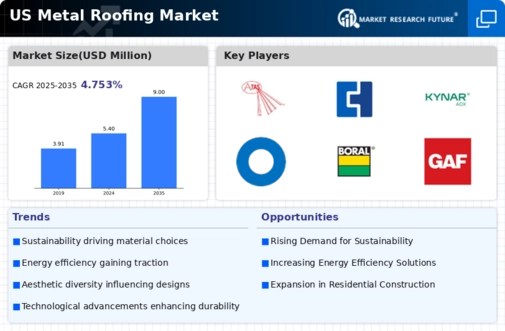The US Metal Roofing Market is characterized by a dynamic competitive landscape, propelled by the increasing demand for durable and sustainable roofing solutions. This sector has witnessed significant growth due to the rising awareness of energy efficiency, environmental concerns, and the longevity of metal roofing materials compared to traditional roofing options. With various manufacturers and suppliers operating in this market, the competition is shaped by innovation, distribution channels, pricing strategies, and customer service. Players in this industry strive to differentiate their offerings through enhanced product features, performance, and aesthetic appeal.
Market dynamics are influenced by technological advancements and changes in consumer preferences, ensuring a continually shifting competitive environment.Sheffield Metals International has established a prominent presence within the US Metal Roofing Market, showcasing a robust portfolio of metal roofing systems and accessories. The company's strengths lie in its commitment to quality and sustainability, which resonate well with eco-conscious consumers and builders alike. Sheffield Metals International has developed a reputation for high-quality products that provide exceptional durability and performance in various climate conditions.
Their extensive network of distributors and installers enhances their market reach, making their solutions accessible to a broad range of customers. Their focus on ongoing research and development allows them to stay ahead of market trends, continually innovating to meet the evolving needs of the roofing industry.
This positioning solidifies Sheffield Metals International's competitive edge within the market by enabling them to offer cutting-edge solutions that align with contemporary building demands.Creative Building Solutions has carved out a niche in the US Metal Roofing Market by offering comprehensive services and a wide array of metal roofing products tailored for a diverse clientele. The company is known for its high-quality metal roofing systems designed for both residential and commercial applications, emphasizing durability and aesthetic versatility.
Creative Building Solutions has fostered strategic partnerships and collaborations that bolster its market presence, while its commitment to excellent customer service ensures strong customer loyalty. The company actively engages in mergers and acquisitions to expand its product line and enhance its capabilities, allowing it to adapt to market changes and drive growth. By focusing on innovation and maintaining a strong supply chain, Creative Building Solutions effectively positions itself as a leader in providing metal roofing solutions that meet the specific needs of the US market.


















